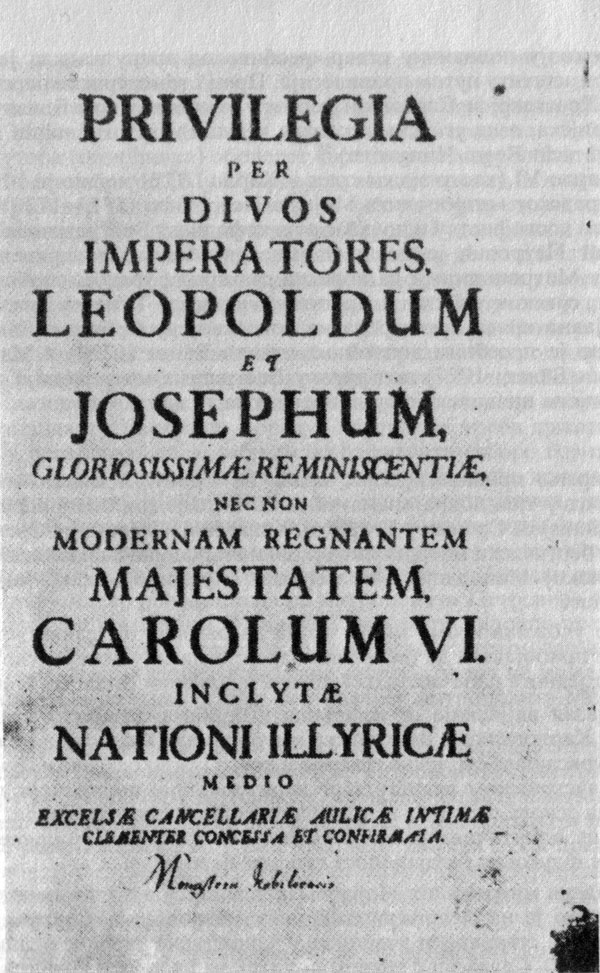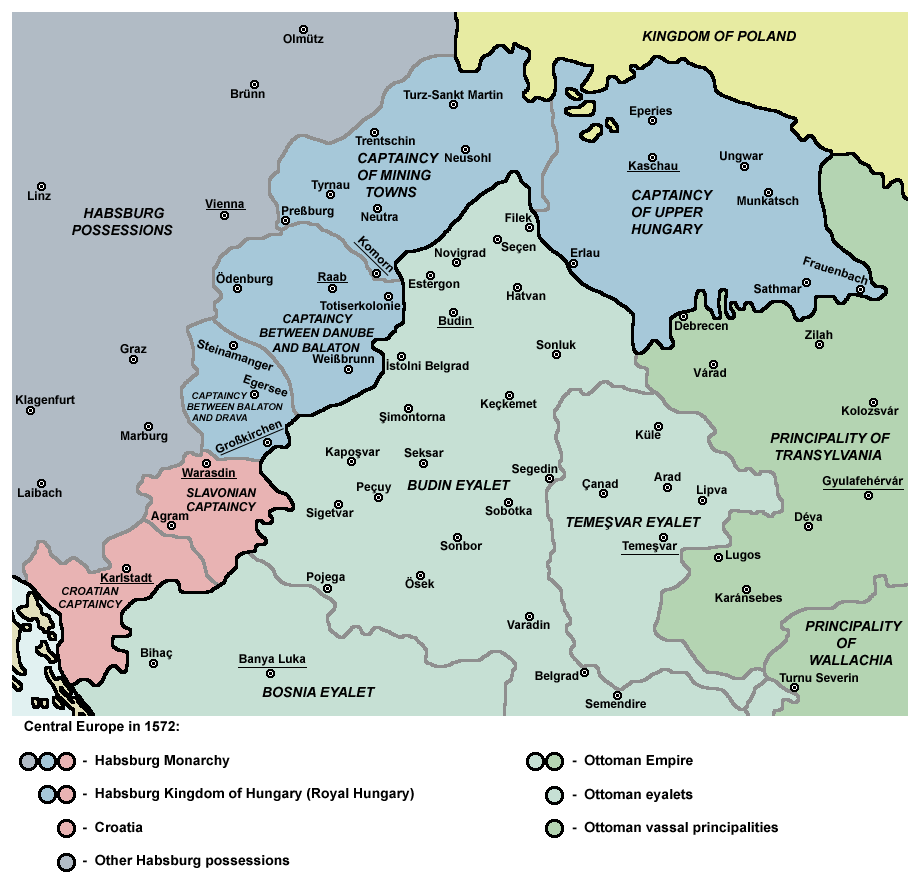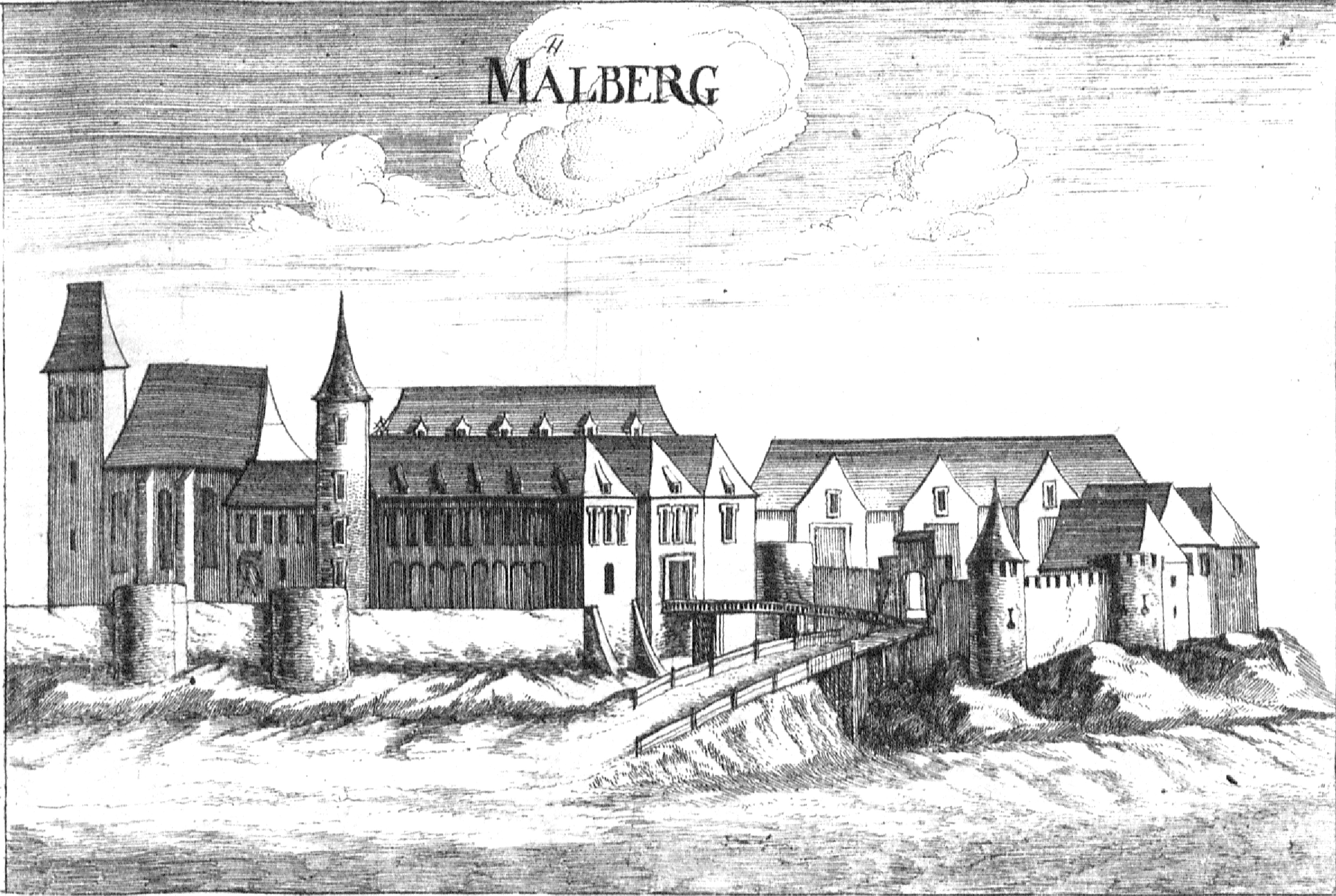|
Metropolitanate Of Karlovci
The Metropolitanate of Karlovci ( sr, Карловачка митрополија, Karlovačka mitropolija) was a metropolitanate of the Eastern Orthodox Church that existed in the Habsburg monarchy between 1708 and 1848. Between 1708 and 1713, it was known as the Metropolitanate of Krušedol, and between 1713 and 1848, as the Metropolitanate of Karlovci. In 1848, it was elevated to the Patriarchate of Karlovci, which existed until 1920, when it was merged with the Metropolitanate of Belgrade and other Eastern Orthodox jurisdictions in the newly established Kingdom of Serbs, Croats and Slovenes to form the Serbian Orthodox Church. History During the 16th and 17th centuries, all of the southern and central parts of the former medieval Kingdom of Hungary were under Turkish rule and organized as Ottoman Hungary. Since 1557, Serbian Orthodox Church in those regions was under jurisdiction of the Serbian Patriarchate of Peć. During the Austro-Turkish War (1683–1699), muc ... [...More Info...] [...Related Items...] OR: [Wikipedia] [Google] [Baidu] |
Eastern Orthodox Church
The Eastern Orthodox Church, also called the Orthodox Church, is the second-largest Christian church, with approximately 220 million baptized members. It operates as a communion of autocephalous churches, each governed by its bishops via local synods. The church has no central doctrinal or governmental authority analogous to the head of the Roman Catholic Church—the Pope—but the Ecumenical Patriarch of Constantinople is recognized by them as ''primus inter pares'' ("first among equals"), which may be explained as a representative of the church. As one of the oldest surviving religious institutions in the world, the Eastern Orthodox Church has played a prominent role in the history and culture of Eastern and Southeastern Europe. The Eastern Orthodox Church officially calls itself the Orthodox Catholic Church. Eastern Orthodox theology is based on holy tradition, which incorporates the dogmatic decrees of the seven ecumenical councils, the Scriptures, and the tea ... [...More Info...] [...Related Items...] OR: [Wikipedia] [Google] [Baidu] |
Ottoman Hungary
Ottoman Hungary ( hu, Török hódoltság) was the southern and central parts of what had been the Kingdom of Hungary in the late medieval period, which were conquered and ruled by the Ottoman Empire from 1541 to 1699. The Ottoman rule covered almost the entire region of the Great Hungarian Plain (except the northeastern parts) and Southern Transdanubia. The territory was invaded and annexed to the Ottoman Empire by Sultan Suleiman the Magnificent between 1521 and 1541. The north-western rim of the Hungarian kingdom remained unconquered and recognised members of the House of Habsburg as Kings of Hungary, giving it the name "Royal Hungary". The boundary between the two thereupon became the frontline in the Ottoman–Habsburg wars over the next 150 years. Following the defeat of the Ottomans in the Great Turkish War, most of Ottoman Hungary was ceded to the Habsburgs under the Treaty of Karlowitz in 1699. During the period of Ottoman rule, Hungary was divided for administrative ... [...More Info...] [...Related Items...] OR: [Wikipedia] [Google] [Baidu] |
Branković Dynasty
The House of Branković ( sr-Cyrl, Бранковић, Brankovići / Бранковићи, ) is a Serbian medieval noble family and dynasty. According to genealogies created in the first half of the 15th century, the family descends via female lineage, through marriage with the Nemanjić dynasty. The family rose to prominence during the fall of the Serbian Empire. The original family domains were centered in the Kosovo region. Later family members extended their rule over all remaining unconquered regions of Serbia making them the last sovereign rulers of medieval Serbian state. The dynasty ruled the Serbian Despotate from 1427 to 1459 and their descendants continue to claim the throne of the Despotate Serbia, some having entered the ranks of the Hungarian aristocracy, while other descendants of the dynasty continue to go by a courtesy title. Members of the family intermarried with other noble houses from neighbouring countries including Austrian and Hungarian nobility, and prov ... [...More Info...] [...Related Items...] OR: [Wikipedia] [Google] [Baidu] |
Isaija Đaković
Isaija Đaković or Isaija I (Grabovac, near Stari Slankamen, Habsburg monarchy, 1635 – Vienna, Habsburg Monarchy, 20 July 1708) was elected to the rank of Metropolitan of Krušedol ( Karlovci) in 1708. Isaija is best remembered as the first Serbian metropolite under Habsburg monarchy and for his diplomatic skills when he obtained the amendments in the Privileges. He was succeeded by Sofronije Podgoričanin. Biography Đaković was born in the village of Grabovac, near Stari Slankamen, located in today's Inđija municipality in the Syrmia District of Serbia. He graduated from elementary school, gymnasium and the Theological Seminary. He married his village sweetheart before being ordained in the priesthood. His wife died prematurely, and he gave up everything for Christ and accepted monasticism at the Krušedol Monastery. Later on, as an educated monk who spoke perfect German, he was elevated to the rank of Bishop of ''Jenopolje'' (Ineu in modern Romania). In Belgrade ... [...More Info...] [...Related Items...] OR: [Wikipedia] [Google] [Baidu] |
Arsenije IV Jovanović Šakabenta
Arsenije IV Jovanović Šakabenta ( sr-cyr, Арсеније IV Јовановић Шакабента, ; 1698 – 18 January 1748) was the Archbishop of Peć and Serbian Patriarch from 1725 to 1737 and Head of the Serbian Orthodox Church in Habsburg Monarchy from 1737 to his death in 1748. He commissioned the Slavic heraldic bearings called '' Stemmatographia.'' He opened the first official Academy of Painting on the territory of the Metropolitanate of Karlovci after the artistic and cultural reforms were commenced under the auspices and blessing of Vikentije Jovanović, his predecessor. He was succeeded by Joannicius III of Constantinople. Biography Treaty of Belgrade With the 1739 Treaty of Belgrade which ended the Austro-Turkish War (1737–1739), the Kingdom of Serbia ceased to exist. The Ottoman sultan deposed the pro-Serbian Patriarch of Peć Arsenije IV and in his place appointed the Greek Joannicius, who took the title of ''Archbishop of Peć and Patriarch of the ... [...More Info...] [...Related Items...] OR: [Wikipedia] [Google] [Baidu] |
Leopold Karl Von Kollonitsch
Leopold Karl von Kollonitsch (also spelt ''Collonicz'', ''Colonitz'', ''Kollonitz'', ''Kolonits'' and ''Kolonić''; 26 October 1631 – 20 January 1707) or Lipót Kollonich was a cardinal of the Holy Roman Church, Archbishop of Kalocsa and later of Esztergom, and Primate of Hungary. Also a count of the Holy Roman Empire, he was a leading figure of the Hungarian Counter-reformation. As an imperial minister, Kollonitsch was responsible for reorganizing the new Hungarian territories won from the Ottoman Empire and later ceded at the Treaty of Karlowitz. He was said to have gained over one hundred thousand converts to Rome from Orthodox Christianity. Early life and military career Born at the Hungarian castle of Komárom (now Komárno), Leopold Karl von Kollonitsch was the son of Count Ernst von Kollonitsch, Governor of the castle, by his marriage to Anne Elizabeth von Kueffstein. He became a candidate officer of the Sovereign Military Order of Malta, first seeing action in th ... [...More Info...] [...Related Items...] OR: [Wikipedia] [Google] [Baidu] |
Cardinal (Catholic Church)
A cardinal ( la, Sanctae Romanae Ecclesiae cardinalis, literally 'cardinal of the Holy Roman Church') is a senior member of the clergy of the Catholic Church. Cardinals are created by the ruling pope and typically hold the title for life. Collectively, they constitute the College of Cardinals. Their most solemn responsibility is to elect a new pope in a conclave, almost always from among themselves (with a few historical exceptions), when the Holy See is vacant. During the period between a pope's death or resignation and the election of his successor, the day-to-day governance of the Holy See is in the hands of the College of Cardinals. The right to participate in a conclave is limited to cardinals who have not reached the age of 80 years by the day the vacancy occurs. In addition, cardinals collectively participate in papal consistories (which generally take place annually), in which matters of importance to the Church are considered and new cardinals may be created. Car ... [...More Info...] [...Related Items...] OR: [Wikipedia] [Google] [Baidu] |
Joseph I, Holy Roman Emperor
Joseph I (Joseph Jacob Ignaz Johann Anton Eustachius; 26 July 1678 – 17 April 1711) was Holy Roman Emperor and ruler of the Austrian Habsburg monarchy from 1705 until his death in 1711. He was the eldest son of Emperor Leopold I from his third wife, Eleonor Magdalene of Neuburg. Joseph was crowned King of Hungary at the age of nine in 1687 and was elected King of the Romans at the age of eleven in 1690. He succeeded to the thrones of Bohemia and the Holy Roman Empire when his father died. Joseph continued the War of the Spanish Succession, begun by his father against Louis XIV of France, in an attempt to make his younger brother Charles (later Emperor Charles VI) King of Spain. In the process, however, owing to the victories won by his military commander, Prince Eugene of Savoy, he did succeed in establishing Austrian hegemony over Italy. Joseph also had to contend with a protracted revolt in Hungary, fomented by Louis XIV. Neither conflict was resolved until the Treaty of ... [...More Info...] [...Related Items...] OR: [Wikipedia] [Google] [Baidu] |
Leopold I, Holy Roman Emperor
Leopold I (Leopold Ignaz Joseph Balthasar Franz Felician; hu, I. Lipót; 9 June 1640 – 5 May 1705) was Holy Roman Emperor, King of Hungary, List of Croatian monarchs, Croatia, and List of Bohemian monarchs, Bohemia. The second son of Ferdinand III, Holy Roman Emperor, by his first wife, Maria Anna of Spain, Leopold became heir apparent in 1654 by the death of his elder brother Ferdinand IV, King of the Romans, Ferdinand IV. Elected in 1658, Leopold ruled the Holy Roman Empire until his death in 1705, becoming the second longest-ruling Habsburg emperor (46 years and 9 months). He was both a composer and considerable patron of music. Leopold's reign is known for conflicts with the Ottoman Empire in the Great Turkish War (1683-1699) and rivalry with Louis XIV, a contemporary and first cousin (on the maternal side; fourth cousin on the paternal side), in the west. After more than a decade of warfare, Leopold emerged victorious in the east thanks to the military talents of Prince E ... [...More Info...] [...Related Items...] OR: [Wikipedia] [Google] [Baidu] |
Great Migrations Of The Serbs
The Great Migrations of the Serbs ( sr, Велике сеобе Срба), also known as the Great Exoduses of the Serbs, refers mainly to two large migrations of Serbs from various territories under the rule of the Ottoman Empire to regions under the rule of the Habsburg monarchy in the 17th and 18th centuries. The First Great Migration occurred during the Habsburg-Ottoman War (1683-1699) under Serbian Patriarch Arsenije III Crnojević as a result of the Habsburg retreat and the Ottoman reoccupation of southern Serbian regions, which were temporarily held by the Habsburgs between 1688 and 1690. The Second Great Migration took place during the Habsburg-Ottoman War (1737-1739), under the Serbian Patriarch Arsenije IV Jovanović, also parallel with the Habsburg withdrawal from Serbian regions; between 1718 and 1739, these regions were known as the Kingdom of Serbia. The masses of earlier migrations from the Ottoman Empire are considered ethnically Serb, and those of the First ... [...More Info...] [...Related Items...] OR: [Wikipedia] [Google] [Baidu] |
Belgrade
Belgrade ( , ;, ; Names of European cities in different languages: B, names in other languages) is the Capital city, capital and List of cities in Serbia, largest city in Serbia. It is located at the confluence of the Sava and Danube rivers and the crossroads of the Pannonian Basin, Pannonian Plain and the Balkan Peninsula. Nearly 1,166,763 million people live within the administrative limits of the City of Belgrade. It is the third largest of all List of cities and towns on Danube river, cities on the Danube river. Belgrade is one of the List of oldest continuously inhabited cities, oldest continuously inhabited cities in Europe and the world. One of the most important prehistoric cultures of Europe, the Vinča culture, evolved within the Belgrade area in the 6th millennium BC. In antiquity, Thracians, Thraco-Dacians inhabited the region and, after 279 BC, Celts settled the city, naming it ''Singidunum, Singidūn''. It was Roman Serbia, conquered by the Romans under the reign ... [...More Info...] [...Related Items...] OR: [Wikipedia] [Google] [Baidu] |
Patriarchate Of Peć (monastery)
The Patriarchate of Peć Monastery ( sr, Манастир Пећка патријаршија, Manastir Pećka patrijaršija, ; sq, Patrikana e Pejës) or the Patriarchal Monastery of Peć, is a medieval Serbian Orthodox monastery located near the city of Peja, Kosovo. Built in the 13th century, it became the residence of Serbian Archbishops. It was expanded during the 14th century, and in 1346, when the Serbian Patriarchate of Peć was created, the Monastery became the seat of Serbian Patriarchs. The monastery complex consists of several churches, and during medieval and early modern times it was also used as mausoleum of Serbian archbishops and patriarchs. Since 2006, it is part of the " Medieval Monuments in Kosovo", a combined World Heritage Site along with three other monuments of the Serbian Orthodox Church. The monastery is ecclesiastically administrated by the Eparchy of Raška and Prizren, but it has special ( stavropegial) status, since it is under direct jurisdiction ... [...More Info...] [...Related Items...] OR: [Wikipedia] [Google] [Baidu] |









.jpg)
